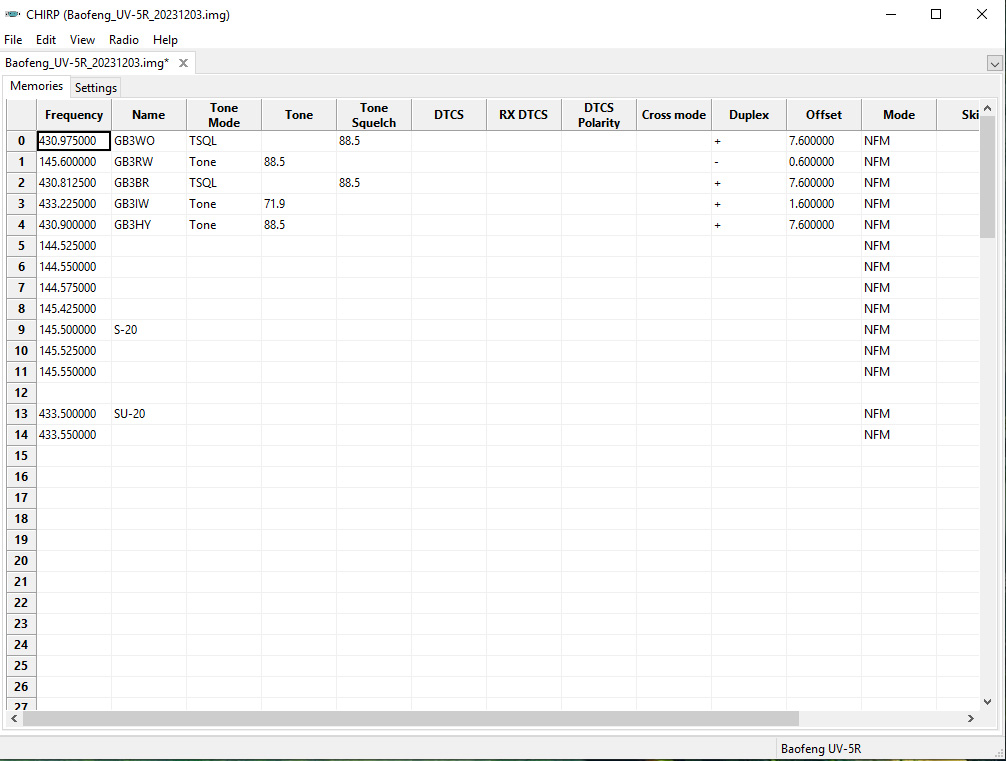Frequency coverage update 2023:
Baofeng radios are often advertised as covering VHF 136-174MHz / UHF 400-480MHz, transmit and receive. However, they have now been set at the factory to cover VHF 144.00 – 145.997 / UHF 430.00 to 439.997. They will not transmit or receive outside these amateur bands. A factory reset will not open up the radio. The only option is to connect your Baofeng to your PC and program the radio that way.
Manual Programming:
0 SQL: squelch level: 0-9
1 STEP: frequency step: 0 2.5, 1 5, 2 6.25, 3 10, 4 12.5, 5 25
2 TXP: transmit power: 0 high, 1 low
3 SAVE: battery save: 0 off, 1 1:1, 2 1:2, 3 1:3, 4 1:4
4 VOX: 0 off, 1-10
5 WN: wideband/narrowband: 0 wide, 1 narrow
6 ABR: display illumination: 0 off, 1, 2, 3, 4, 5 seconds
7 TDR: dual watch reception: 0 off, 1 on
8 BEEP: keypad beep: 0 off, 1 on
9 TOT: transmission timer: 0 15, 1 30, 2 45, 3 60, … 585 and 600 seconds in 15-second increments
10 R-DCS: reception digital coded squelch
11 R-CTCS: reception continuous tone coded squelch
12 T-DCS: transmission digital coded squelch
13 T-CTCS: transmission continuous tone coded squelch
14 VOICE: voice prompt: 0 off, 1 on (older versions), 0 off, 1 English, 2 Chinese (Newer versions)
15 ANI-ID, automatic number identification of the radio: can only be set by pc software
16 DTMFST: DTMF tone of transmitting code: 0 off, 1 dt-st, 2 ani-st, 3 dt+ani
17 S-CODE: signal code: only could be set by pc software
18 SC-REV: scan resume method: 0 TO, 1 CO, 2 SE
19 PTT-ID: push to talk id: 0 off, 1 bot, 2 eot, 3 both
20 PTT-LT: delay the signal code sending, 0-30 Ms
21 MDF-A: (under channel mode the channel displays): 0 frequency, 1 channel number, 2 name (name is only programmable via programming software)
22 MDF-B: same as menu 21, for b band
23 BCL: busy channel lockout: 0 off, 1 on. [Note: This doesn’t lock out a channel from memory scan. It prevents transmitting on a busy channel and is programmed on a per channel basis.]
24 AUTOLK: keypad locked automatically: 0 off, 1 on
25 SFT-D: direction of frequency shift: 0 off, 1 plus, 2 minus
26 OFFSET: frequency shift: 0-69.990 MHz
27 MEM-CH: store memory channels: 000-127
28 DEL-CH: delete memory channel: 000-127
29 WT-LED: illumination display colour of stand by: 0 off, 1 blue, 2 orange, 3 purple
30 RX-LED: illumination display colour of reception: 0 off, 1 blue, 2 orange, 3 purple
31 TX-LED: illumination display colour of transmission: 0 off, 1 blue, 2 orange, 3 purple
32 AL-MOD: alarm mode: 0 site, 1 tone, 2 code
33 BAND: band selection: 0 VHF, 1 UHF
34 TDR-AB: transmit+ selection while in dual watch/reception: 0 off, 1 a, 2 b
35 STE: tail tone elimination: 0 off; 1 on
36 RP-STE: tail tone elimination in communication through repeater: 0 off; 1-10
37 RPT-RL: delay of tail tone of repeater: 0 off; 1-10
38 PONMSG: boot display: 0 full; 1 mgs
39 ROGER: tone end of transmission: 0 off; 1 on
40 RESET: restore to default setting: 0 VFO; 1 all
Computer Programming with Chirp:
When you’ve connected your radio to your computer and downloaded from your radio, you’ll have a screen similar to the one below. It’s self explanatory really. If you’re programing a simplex channel, enter the frequency in the frequency column. You can name the channel, if you wish. If there’s no name entered, the radio will display the frequency. If you are programing a repeater channel, enter the repeater output frequency in the frequency column. Name the repeater, if you wish. In the tone column, enter the CTCSS code for the repeater. In the duplex column, enter the shift direction + or -. In the offset column, enter the repeater offset. Most repeaters are narrowband so enter NFM.
If you enter the CTCSS frequency in the Tone Squelch column, your receiver will need to hear a CTCSS tone from the repeater to open the squelch. The tone will operate on TX and RX, so the repeater will open when you transmit. Some repeaters don’t transmit a CTCSS tone so you will not hear the repeater if you’ve used the Tone Squelch column.
Instruction Manual here.

